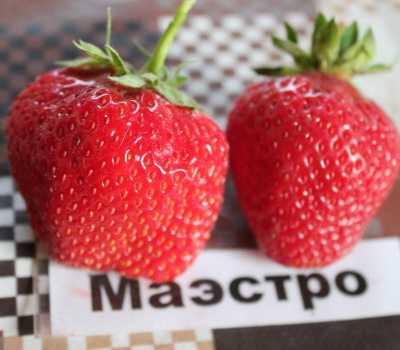
- Authors: France
- Taste: sweet
- The size: large
- Weight: 70-90 gr
- Yield rate: high
- Yield: up to 2.5 kg per bush
- Repairability: Yes
- Ripening terms: early
- Appointment: fresh consumption, processing (juice, jam, jam, etc.)
- Description of the bush: powerful, compact
The Maestro strawberry is a hybrid variety that was bred by French breeders. For Russian summer residents, the variety is still little known, we suggest you get to know it better.
Description of the variety
The Maestro variety is characterized by the following features:
the bush is powerful, compact, 40 cm high;
superficial roots, located at a maximum depth of 30 cm, live 3-4 years;
leaves are light green, trifoliate, develop on petioles up to 25 cm high;
shoots - whiskers, on which 1-3 sockets are formed;
flowers grow on long peduncles, are white in color, and are considered good honey plants.
Ripening terms
The Maestro variety belongs to remontant varieties, the ripening period is early. Strawberries bear fruit from late May to late autumn.
Yield
The plant is distinguished by a high degree of productivity: up to 2.5 kg of tasty fruits are harvested from one bush.
Berries and their taste
The berries are bright red, conical in shape, large in size, weighing up to 90 g. The berries taste sweet, the pulp is juicy and dense, which ensures high marketability and good transportability. There is a pronounced pineapple aroma. The purpose of the fruits is universal, it is possible to use them fresh, processing for jam or compote, freezing is allowed.
Growing features
Maestro belongs to frost-resistant and drought-resistant varieties. To get a good harvest, there are several important factors to consider.
The plant responds well to medium watering rates. It should be increased in dry summers.
It is important to regularly remove weeds and loosen the soil.
At least once every 2-3 weeks, the culture is fed with potassium-phosphorus compositions. Apply nitrogen mixtures in early spring or fall.
Do not grow Maestro in one place for more than 4 years.
It is allowed to keep the plant in a greenhouse.




Site selection and soil preparation
When choosing a site, give preference to sunny places, shading of Maestro's strawberries is optional. But culture reacts badly to a draft. Avoid wetlands, but if there are no other options, then raise the level of the ridges and plant bushes at the top. Planting consists of several stages:
digging the ridge;
digging furrows 25 cm deep;
laying out peat combined with ash on the bottom;
placement of a seedling;
backfilling the soil;
watering and mulch application.
The recommended planting pattern is 30x40cm.

Pollination
The presented variety has bisexual flowers, which means that it belongs to the self-pollinating varieties. Good pollination is observed even under unfavorable conditions.

One of the important techniques in strawberry care is feeding. Regular fertilization guarantees a rich harvest. There are several different ways to feed strawberries, and each of them is designed for a specific period of plant development. During flowering, fruiting and after it, feeding should be different.
Frost resistance and the need for shelter
To help the bushes survive the winter, you need to start forming rows. In preparation for frost, the mustache with rosettes is removed from the aisle, old leaves are removed. During this period, nitrogen fertilizers will be relevant. You can insulate the bushes with mulch, which is a layer of peat and a layer of straw. If strawberries are planted in a region where the temperature reaches -30 degrees in winter, then the plants are covered with a film.

Diseases and pests
Maestro's strawberry is highly resistant to insect attacks and diseases due to its hybrid origin. However, sometimes the scent of the berries can attract slugs.

Strawberries are often subject to many dangerous diseases that can seriously undermine its condition. Among the most common are powdery mildew, gray mold, brown spot, anthracnose, and verticillosis. Before buying a variety, you need to inquire about its disease resistance.
Reproduction
It is customary to breed strawberries of the presented variety with rosettes from the mother bush. To get a future bush, the shoot must be pressed to the ground and fixed, it is advisable to add a layer of fertile soil around the outlet. When the seedlings take root, they are separated from the main bush and distributed on the site.
In large farms, seed reproduction is practiced, but this is a complex process that takes a lot of time and effort. But the method of dividing the bush is not at all recommended for this species due to the low survival rate of the variety.



















































































